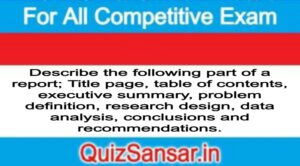
Describe the following part of a report; Title page, table of contents, executive summary, problem definition, research design, data analysis, conclusions and recommendations.
Describe the following part of a report; Title page, table of contents, executive summary, problem definition, research design, data analysis, conclusions and recommendations.
Ans.
Layout of the Research Report
Anybody, who is reading the research report, must necessarily be conveyed enough about the study so that he can place it in its general scientific context, judge the adequacy of its methods and thus form an opinion of how seriously the findings are to be taken. For this purpose there is the need of proper layout of the report. The layout of the report means as to what the research report should contain. A comprehensive layout of the research report should comprise the follows:
Preliminary Pages
In its preliminary pages the report should carry a title and date, followed by acknowledgements in the form of ‘Preface’ or ‘Foreword’. Then there should be a table of contents followed by list of tables and illustrations so that the decision-maker or anybody interested in reading the report can easily locate the required information in the report.
Main Text
The main text provides the complete outline of the research report along with all details. Title of the research study is repeated at the top of the first page of the main text and then follows the other details on pages numbered consecutively, beginning with the second page. Each main section of the report should begin on a new page. The main text of the report should have the following sections:
(i) Introduction: The purpose of introduction is to introduce the research project to the readers. It should contain a clear statement of the objectives of research i.e., enough background should be given to make clear to the reader why the problem was considered worth investigating. A brief summary of other relevant research may also be stated so that the present study can be seen in that context. The hypotheses of study, if any, and the definitions of the major concepts employed in the study should be explicitly stated in the introduction of the report.
The methodology adopted in conducting the study must be fully explained. The scientific reader would like to know in detail about such thing: How was the study carried out? What was its basic design? If the study was an experimental one, then what were the experimental manipulations? If the data were collected by means of questionnaires or interviews, then exactly what questions were asked (The questionnaire or interview schedule is usually given in an appendix)? If measurements were based on observation, then what instructions were given to the observers? Regarding the sample used. in the study the reader should be told: Who were the subjects? How many were there? How were they selected? All these questions are crucial for estimating the probable limits of generalizability of the findings. The statistical analysis adopted must also be clearly stated. In addition to all this, the scope of the study should be stated and the boundary lines be demarcated. The various limitations, under which the research project was completed, must also be narrated.
(ii) Statement of findings and recommendations: After introduction, the research report must contain a statement of findings and recommendations in non-technical language so that it can be easily understood by all concerned. If the findings happen to be extensive, at this point they should be put in the summarized form.
(iii) Results: A detailed presentation of the findings of the study, with supporting data in the form of tables and charts together with a validation of results, is the next step in writing the main text of the report. This generally comprises the main body of the report, extending over several chapters. The result section of the report should contain statistical summaries and reductions of the data rather than the raw data. All the results should be presented in logical sequence and splitted into readily identifiable sections. All relevant results must find a place in the report. But how one is to decide about what is relevant is the basic question. Quite often guidance comes primarily from the research problem and from the hypotheses, if any, with which the study was concerned. But ultimately the researcher must rely on his own judgement in deciding the outline of his report.
(iv) Implications of the results: Toward the end of the main text, the researcher should again put down the results of his research clearly and precisely. He should, state the implications that flow from the results of the study, for the general reader, is interested in the implications for understanding the human behavior. Such implications may have three aspects as stated below:
(a) A statement of the inferences drawn from the present study which may be expected to apply in similar circumstances.
(b) The conditions of the present study which may limit the extent of legitimate generalizations of the inferences drawn from the study.
(c) The relevant questions that still remain unanswered or new questions raised by the study along with suggestions for the kind of research that would provide answers for them.
It is considered a good practice to finish the report with a short conclusion which summarizes and recapitulates the main points of the study. The conclusion drawn from the study should be clearly related to the hypotheses that were stated in the introductory section. At the same time, a forecast of the probable future of the subject and an indication of the kind of research which needs to be done in that particular field is useful and desirable.
(v) Summary: It has become customary to conclude the research report with a very brief summary, resting in brief the research problem, the methodology, the major findings and the major conclusions drawn from the research results.
End Matter
At the end of the report, appendices should be enlisted in respect of all technical data such as questionnaires, sample information, mathematical derivations and the like ones. Bibliography of sources consulted should also be given. Index should invariably be given at the end of the report. The value of index lies in the fact that it works as a guide to the reader for the contents in the report.






